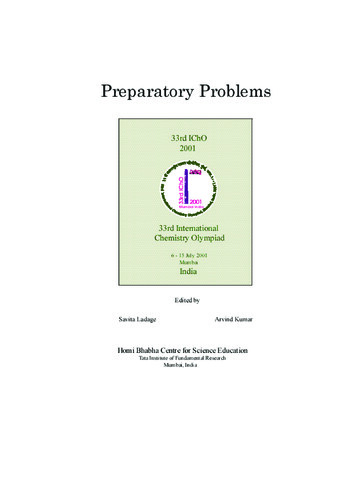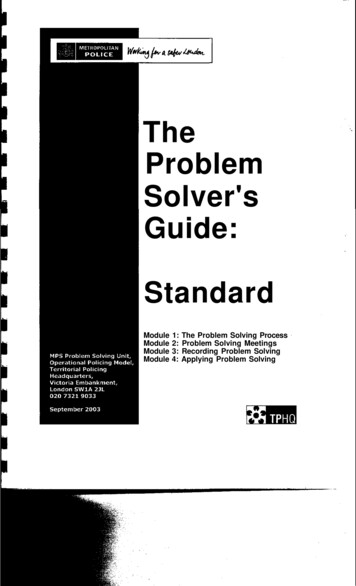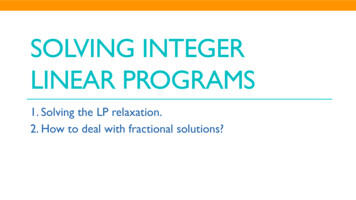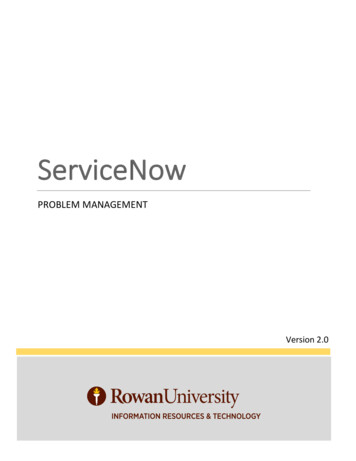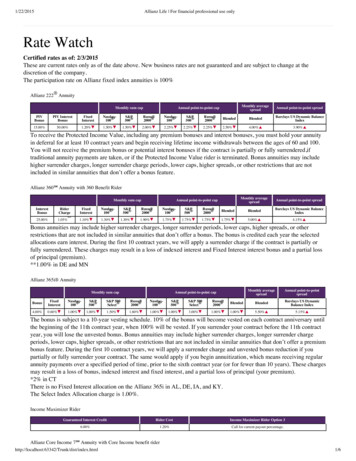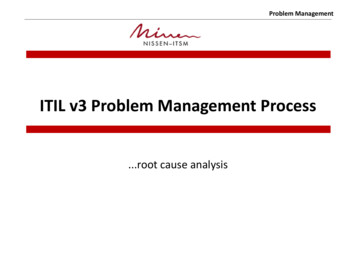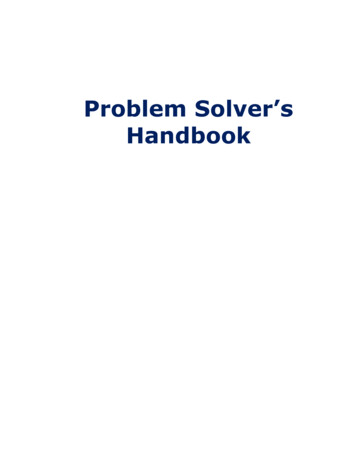
Transcription
Faculty of Economic Sciences, Communication and ITBusiness administrationSveinung JørgensenWhat’s the Problem?Reformulating the Problem forBalanced-Strategy CreationDISSERTATIONKarlstad University Studies2011:41
Sveinung JørgensenWhat’s the Problem?Reformulating the Problem forBalanced-Strategy CreationKarlstad University Studies2011:41
Sveinung Jørgensen, Lillehammer University College. What’s the Problem?Reformulating the Problem for Balanced-Strategy CreationDISSERTATIONKarlstad University Studies 2011:41ISSN 1403-8099ISBN 978-91-7063-376-8 The authorDistribution & publishing:Karlstad University PressKarlstad University LibraryS-651 87 KarlstadSwedenwww.kau.se/kupPrint: Universitetstryckeriet, Karlstad 2011
AbstractBy asking “What’s the problem?” this thesis addresses the crucial relationshipbetween how strategic decision-makers formulate organizational problems andhow the relevant actors attempt to solve these problems. This thesis holds thatthe creation of strategy can be conceived of as a decision-making process inwhich the strategists find, formulate and attempt to solve problems by choosing aset of means to reduce the perceived gap between the current state and the desiredstate of the organization. The thesis particularly explores and postulates what isreferred to as the means-end fallacy in which end-problems are treated as meansproblems. In effect the decision-makers take the ends of the organization forgranted and only ask “How can we fix it?” instead of critically examining thepurpose of the organization by asking “What should we fix and why?”The purpose of this thesis is twofold. First, it is to explore the dysfunctionalconsequences of the means-end fallacy in organizational decision-making andcreation of strategy. Secondly, it is to illuminate the implications of applying theproblem-formulation perspective in the creation of organizational strategies. Toachieve these purposes the problem-formulation phenomenon is explored infive appended papers. Paper I discusses the paradox of profitability andresponsibility and the means-end fallacy in the context of strategic theory andpractice. Papers II, III and IV explore the relationship between how a problemis formulated and how different actors attempt to solve it. This is done with acomprehensive case study of the substance-abuse problem and the differentorganizational strategies that are implemented to resolve it. Paper V offers aconcrete discussion of how inappropriate formulations of organizationalproblems undermine the intended ends, particularly with regard to the paradoxof profitability and responsibility.This thesis argues that the strategic decision-makers need both to be moreproblem-oriented; that they should balance the different dimensions of theproblem; and, thus, that they should recognize that decision-making is an art ofbalance. Moreover, it suggests that the problem-formulation perspective cancontribute with an insight into the black box of strategy creation, and that this canbe achieved by looking back or rewinding from the organization’s strategy to theinitial formulation of the organization’s problems. As a mirror image it suggeststhat strategic decision-makers can avoid the means-end fallacy by forwardingfrom an appropriate formulation of the problem to a balanced strategy.3
4
PrefaceThis thesis is about the (re)formulation of problems. Thus, the last fewyears this doctoral thesis has indeed been a problem for me. When I startedstruggling with this problem it was by no means framed in the same way as it isnow. Rather, my understanding of the problem has evolved as I have tried tograsp it, and, hence, the thesis has been more a result of an organic than anorganized process. Both the doctoral program itself and the process of writingthis thesis have been an instructive experience that I have found mostrewarding. That said, I must admit that I have been looking forward tofinishing this thesis and starting afresh with new research projects andproblems.The thesis is based on five appended papers, each addressing theformulation of different problems and the creation of organizational strategies.Four of these papers are written together with my dear friend, (now Dr.) LarsJacob Tynes Pedersen (Norwegian School of Economics and BusinessAdministration – NHH). We met in 2007 and it was Lars Jacob who introducedme to the problem-formulation perspective. Soon we started developing aconceptual framework on the formulation of problems and we decided toinvestigate the substance-abuse problem. Later, as this thesis shows, we haveelaborated on this framework and we have employed it to explore differentproblems in different empirical and theoretical contexts. At the present time weare developing a proposal for a research project, Responsibility in Organizations(see Jørgensen & Pedersen, 2011d), which seeks to follow up on some of theresearch questions we have been working on over the last few years.Neither the substance-abuse problem nor the problem-formulationperspective was a part of my initial research proposal. But the choice of thesubstance-abuse problem was not a coincidental one. At the age of 19, in 1995,I moved into and started working at the rehabilitation facility Tyrilitunet, whichis a part of the Tyrili Foundation.1 Here I lived and worked for three years; hereI learned some very important lessons; and here I even met my wife. Thus, theexperiences and friendships I earned at Tyrili have become an important part ofmy life. Therefore, I am pleased that Tyrili and the substance-abuse problemare part of this thesis.Before I became a research fellow at Lillehammer University College(HiL) in 2007, I was working at HiL as an assistant professor. At HiL I alsostarted to study business administration in 1998. Then, in 2000, we moved to1See www.tyrili.no.5
Bergen where I studied at NHH. In 2004 we returned to Lillehammer and HiLwhere I started to lecture in strategy and organizational theory. In 2006 Iapplied for a position as a research scholar at what now is called Centre forInnovation in Services (CIS) at HiL. At that time I began my doctoral studies atBodø Graduate School of Business (HHB). However, when my wife becameseriously ill in 2008 I decided to take a break from my doctoral studies. Then,when our life situation started to stabilize in 2009, I continued my doctoralstudies at Karlstad Business School (KBS) at Karlstad University (KAU).AcknowledgementsThis doctoral thesis has made me indebted to many people. I am mostespecially grateful to my supervisor, Professor Per Skålén (KBS), and my cosupervisor, Professor Håvard Teigen (HiL). Per’s creativity, persistence andinsight have greatly influenced my work over the last two years. I sincerely hopethat we can collaborate on new projects in the near future. Håvard has givenme both the necessary attention and the freedom to pursue my own thoughtsand ideas. Not least, Håvard has provided invaluable personal and professionalsupport and advice when they were needed.I am also particularly grateful to Dr. Lars Jacob Tynes Pedersen atNHH. In 2007 we met at the Oslo Airport on our way to a doctoral course atHHB. Our friendship (or bromance) took off even before takeoff to Bodø – andit surely has risen to new heights ever since. Lars Jacob is truly one of thekindest, funniest, smartest and most artistic persons I know. I feel extremelyprivileged to have him as a friend and a collaborator. I also want to thank LarsJacob’s generous wife, Kjersti, and their lovely daughter, Ada, for sharing LarsJacob with me.KBS deserves to be thanked both for their cooperation and flexibility.KBS also arranged an important seminar for me in May 2011 where Dr. MartinFougère and Professor Bo Enquist contributed with invaluable critiques on anearlier version of this thesis.I am also deeply grateful to my colleagues and many friends at HiL andCIS. This community of caring and engaged people, who represent a diversityof specialties and perspectives, has certainly affected this thesis. Together, HiLand CIS have represented a safe haven for me and this research project. There aremany at HiL who deserves to be mentioned, but I choose to highlight TorgeirSkyttermoen and Steven Connolley. Torgeir has thoroughly read and6
commented on almost all of my work, ranging from the initial researchproposal to the first draft of this thesis. Steven has contributed with languageediting and general support in the writing process.I am also grateful to Professor Stig Ingebrigtsen, Professor OveJakobsen and the staff at the Centre of Ecological Economics and Ethics atHHB for providing me with a head start on the doctoral program. ProfessorGeir Kaufmann also deserves my appreciation. I am also deeply grateful toProfessor Odd Nordhaug for publishing my first paper and for encouraging meto continue writing academic texts.I am also indebted to the Tyrili Foundation, and especially ØyvinAamodt and Debby Lorimer for their participation and support. In 1995 it wasØyvin who gave me the opportunity to work at Tyrilitunet, and we have stayedin contact ever since. Øyvin helped me to get access to the informants at Tyrili,and both Øyvin and Debby have been important interlocutors, friends andsources of inspiration for me.I consider myself as a pracademic, meaning that I enjoy the crossroadbetween practice and academics. Happily, while working on this doctoral thesis,I have been involved as a strategic sparring partner in different organizations. Ihave been invited to other universities and organizations to hold seminars andto talk about my doctoral project, and I have taught classes at both HiL andNHH. These opportunities have made me able to employ and elaborate on theproblem-based approach to the creation of organizational strategies. In thisregard I would especially like to thank Trond Hårberg, Norunn Grande, AndersLindstad, Harald Blaaflat Mundal, Stig Hjerkinn Haug and Anders Teigen Hole.I also would like to thank Narve Reiten and Christian Melby, both at Reiten &Co, for co-authoring with me a paper on strategy, creativity and thereformulation of problems.My family and friends deserves my gratitude, especially my mom anddad, Tove and Arne. You have showed persistent interest in my work and youhave contributed with tremendous support for my family when we needed itthe most. The same applies to my parents-in-law, Rannei and Ola. All in all Iam deeply grateful for all the kind words, assistance and love we have receivedfrom our family and friends over the last few years. These have helped me tokeep on track during those periods when my doctoral studies dwindled into aminor detail compared to other, more existential challenges in life.My children, Rannei Johanne and Endre, have both contributedsubstantially to this thesis in so many different ways. You two are the best –and I am truly proud of both of you. Last, but not least, I want to thank my7
wife, best friend, biggest supporter and greatest critic, Ingrid. Your good spirit,positive energy and compassion affect everyone around you. Even when youwere ill you encouraged me to pursue my dream of achieving my doctorate.With great help from our health-care system and your astonishing will andability to recover, you are now back to good health. Rannei Johanne, Endre andIngrid: I honestly believe that this thesis is a result of a team effort. Therefore, Idedicate it to all of you.Lillehammer, August 2011Sveinung Jørgensen8
9
10
To Rannei Johanne,Endre & Ingrid11
12
Table of contents1 Introduction. 171.1 Decision-making and the formulation of problems . 171.2 Strategy creation and the means-end fallacy . 191.3 Main aims, approach and findings . 221.4 The structure of the thesis. 242 Theoretical background . 252.1 The problem-formulation perspective. 252.1.1 Problem-formulation and strategy creation . 252.1.2 The art of finding, formulating and solving problems . 282.1.3 Errors of the third kind and the means-end fallacy . 322.2 Strategic management and strategy creation . 362.2.1 Strategy creation and problem reformulation . 362.2.2 Mainstream strategy – the bottom line . 392.3 Some critical perspectives on the bottom line . 432.3.1 CSR – from bottom to triple bottom lines . 432.3.2 Ecological economics – from bottom lines to interdependent systems . 452.3.3 The critical perspective on CSR – CSR as an oxymoron altogether . 482.4 Summing up and moving on. 503 Methodological choices and case description. 533.1 Methodological reflections . 533.2 The choice of and the evolution of the case study . 563.3 Delimitations . 583.4 Methods . 593.4.1 The qualitative case study including the study of the pharmaceutical industry . 603.4.2 The quantitative part of the case study . 633.5 Validation and reliability issues . 643.6 Case description – illuminating different problem-formulations andstrategies . 663.6.1 The Tyrili Foundation and the reforms in public health care . 663.6.2 The pharmaceutical industry – medicalizing and economizing the problem? . 694 The empirical and conceptual studies . 734.1 A list of the appended papers . 734.2 Paper I: Business as Usual vs. Business Redefined . 744.3 Paper II: What’s the Problem?. 754.4 Paper III: Through Different Eyes . 774.5 Paper IV: Not Your Problem?. 794.6 Paper V: The Why and How of CSR . 805 Conclusions and contributions . 835.1 Theoretical contributions . 8313
5.1.1 Contributions to the problem-formulation perspective . 865.1.2 Contributions to the illumination of the black box of strategy creation . 905.1.3 Contributions to balanced-strategy creation . 945.2 Practical implications of the thesis: What’s your problem? . 975.3 Concluding remarks and reflections . 100References . 103List of figuresFigure 1: What’s the Problem? Strategy creation as problem-formulation . 27Figure 2: Problem formulation and problem-solving (Mitroff, 1998) . 34Figure 3: Economy, nature and culture (Ingebrigtsen & Jakobsen, 2007) . 46Figure 4: A timeline of events in the case . 67Figure 5: Overall contributions – beyond the means. 84List of tablesTable I: Exercises vs. problems (based on Mitroff and Silvers, 2009) . 30Table II: Four approaches to CSR . 8114
Appended papersPaper IJørgensen, S.: 2009, Business as Usual and the Barriers to SustainableInnovations. Beta: Scandinavian Journal of Business Research, 1, pp. 27-44.A previous version of the paper is published in: Nordhaug, O. and Kristiansen,H.-I. (eds.): 2009, Retorikk, etikk og næringsliv [Rhetoric, ethics and business].Oslo, Forlag1.Paper IIJørgensen, S. & L. J. T. Pedersen: 2010, What’s the Problem? A Problem BasedApproach to the Reform of the Norwegian Drug Rehabilitation Sector.European Journal of Social Work, 13, (3), pp. 339-357.Paper IIIJørgensen, S. & L. J. T. Pedersen: 2011a, Through Different Eyes: AnExploration of Divergent Conceptions of the Drug Problem and DrugRehabilitation. Planned for submission in 2011.Paper IVJørgensen, S. & L. J. T. Pedersen: 2011b, Not Your Problem? Exploring theRelationship between Problem Formulation and Social Responsibility. NordicJournal of Applied Ethics, 5, (1), pp. 31-50.Earlier drafts of the paper were presented at i) The national conference for CSRas an innovation driver in business, Trondheim, December 1.-2., 2010 and ii) atThe EBEN Annual Conference, Trento, Italy, September 9.-11., 2010.Paper VJørgensen, S. & L. J. T. Pedersen: 2011c, The Why and How of CSR. Revisedand resubmitted to Beta: Scandinavian Journal of Business Research.15
16
1 Introduction“The mere formulation of a problem is far more often essential than its solution,which may be merely a matter of mathematical or experimental skill.To raise new questions, new possibilities, to regard old problemsfrom a new angle requires creative imaginationand marks real advances in science.”Albert Einstein (1879-1955)“Our major obligation is not to mistakeslogans for solutions.”Edward R. Murrow (1908-1965)“Assumptions are the mother of all fuckups!”Jules (Samuel L. Jackson)Pulp Fiction (1994)1.1 Decision-making and the formulation of problems“What’s the problem?” This intriguing and in many ways unanswerablequestion is the focal point of this thesis. By problems I do not mean obstaclesthat should be avoided, but inescapable and intractable situations or issues thatrequire some kind of resolution (Meyer, 2007). In general, a problem can bedefined as the difference between the present and a desired state (Raaheim,1961). An important premise for this thesis is that organizations are problemsolving systems (Blau & Scott, 1962), and so the choices, decisions and actionsmade by organizations and their individual members ultimately relate to theattempt to solve the problems that they face. I explore how and why differentactors formulate complex problems differently. Moreover, I explore the crucialrelationship between how strategic decision-makers formulate an organizationalproblem and how they attempt to solve it by creating strategies.The thesis conceives the creation of strategy as a decision-making process inwhich the strategists find, formulate and attempt to solve problems by choosing aset of means to reduce the perceived gap between the current state and thepreferred state of the organization. It follows that the problems the strategistsidentify and how they are formulated affect how the strategists attempt to solvethe problem. Accordingly, the manner in which problems are formulated mayaffect which means or strategies individuals, organizations and societies employ.The thesis deals particularly with the difficult task of creating what I call balanced17
strategies. This relates to the art of conceiving of and balancing the differentdimensions inherent in a complex, strategic problem.Improved knowledge about (re)formulations of problems and the creation ofstrategy are important because the way that decision-makers formulate complexissues, like the environmental problem for instance, has consequences for theattempts to solve these problems. If the environmental problem is formulatedas a global-warming problem, the decision-makers will try to solve it bychoosing strategies that reduce the greenhouse effect. One such solution couldbe an increased use of nuclear power. However, nuclear power may have severeconsequences for people, the planet and future profits, negative consequencesthat might outweigh the global-warming problem. The relationship betweenhow a problem is formulated and the attempts to solve it is not only importantfor understanding of general issues like the environmental problem, but it isalso important for solutions to more trivial problems. For instance, a colleaguetold me a story about the preparations for the Winter Olympics in Lillehammerwhere they realized that the toilet capacity for women was insufficient.2 Theirfirst impulse was to order more mobile toilets, but then the reformulation ofthe problem transformed from “there are not enough toilets” to “the toiletvisits last too long.” This reformulation resulted in an entirely different – andperhaps even creative – solution to the problem: they removed the mirrorsfrom the restrooms!Research on the formulations of problems and problem-solving has strong tiesto research on decision-making, which is studied within, for instance,psychology (Tversky & Kahneman, 1974; Simon, 1977; 1979), political science(e.g., Cohen et. al, 1972), organizational theory (March & Simon, 1958; March& Heath, 1994), creativity (Jackson, 2006; Puccio & Cabra, 2009) andbehavioral economics (Ariely, 2008). A common dividing line in this researchfield can be drawn between normative and descriptive decision-making theories.While normative decision-making theories discuss how the decision should bemade (Neumann & Morgenstern, 1947), descriptive theories explore howdecisions are made in practice. In short, one can say that one of thefundamental findings in this research field over the last 50 years is that thedecision-makers are boundedly rational (Simon, ibid.; Kahneman, 2003); that is,they do not necessarily make decisions in accordance with the prescriptions ofrationality (Plous, 1993; Elster, 2007).2Thanks to Harald Blaaflat Mundal.18
This thesis is primarily positioned within the field of descriptive decisionmaking research, thus it seeks to contribute with a greater understanding ofhow decision-making – particularly the formulation of problems and problemsolving – is carried out in practice. Moreover it seeks both to explore theconsequences of inappropriate formulations of different problems and toenvision an alternative, problem-based, approach to the creation oforganizational strategies. One of the consequences of bounded rationality isthat decision-makers have a tendency to jump to conclusions on the basis of asimplified model of reality. The problem-formulation perspective, and thus thisthesis, approaches this bias by focusing on which problems the decision-makersfind, how these are formulated and how this again affects the attempts to solvethe problem. In other words, the problem-formulation perspective attempts toexplore the decision-maker’s simplified model of reality with regard to how thedecision-makers formulate the problem. I propose that the problemformulation perspective (see e.g. Allison & Zelikow, 1999; Eierman & Philip,2003; Mitroff, 1998; Pedersen, 2009; Mitroff & Silvers, 2009) can be used tostudy the creation of organizational strategies (Mintzberg, 1978). Moreover, Ipropose that strategic decision-makers can employ the problem-formulationperspective in the strategy process in order to balance the different purposes ofthe organization and to create balanced strategies. In the following section Ishall introduce the background for these propositions.1.2 Strategy creation and the means-end fallacyA key process in contemporary organizations is to create and execute strategies.However, as described above, studies of human decision-making suggest thatwe make decisions on the basis of a simplified model of reality (e.g. Elster,2007). In general this bias can lead us to being more means- and solutionoriented than end- and problem-oriented. The result is that we seldom ask“What’s the problem?” because we rush to find solutions to the predefinedproblem on the basis of heuristics or rules of thumb. In other words, decisionmakers have a tendency to jump over the two first phases of the decisionmaking process, namely, the finding of a problem and its (re)formulation. In astrategic context, March (1991) draws on insights from decision-making theoryand claims that the mainstream field of strategy is caught up in the rationalanalytical way of thinking, and that this logic is only likely to generateincremental changes and improvements (exploitation), and will not developnew ideas that can lead to successful innovations (exploration). Similarly, Kimand Mauborgne (2005; 2009) argue that strategic decision-makers need to find19
ways of reconstructing their strategies instead of reproducing the samestrategies as the other actors follow in their industry. Thus, they claim thatstrategists need to reformulate the problem and to find new solutions to newproblems instead of trying to find better solutions to the same problems towhich their competitors also subscribe.I aim to contribute to an explorative (cf. March, 1991) and reconstructive (cf.Kim & Mauborgne, 2005; 2009) approach to the creation of strategy byapproaching this phenomenon as a problem-based decision-making process. Inthis thesis I have chosen to concentrate on one challenge related to the creationof strategy, namely, difficulties related to dealing with the critical paradox ofprofitability and responsibility (Wit & Meyer, 2004). I do so by exploring what Irefer to as the means-end fallacy, which is a form of the Error of the third kind (E3)(Mitroff, 1998). In general, an E3 occurs when the decision-makers formulateand solve the wrong problem, that is, when they find solutions that fail toaddress the actual problem. The means-end fallacy denotes those situations inwhich end-problems are treated as means-problems, where the decision-makerstake the purpose or ends of the organization for granted and ask “How can wefix it?” instead of critically examining the purpose of the organization by asking“What should we fix and why?” (Mitroff & Silvers, 2009). Thus, I propose thatthe means-end fallacy can lead individual and organizational decision-makers toformulate and solve the wrong problems because they are fixated on findingsolutions to a predefined problem instead of taking a step backwards in thedecision-making process and trying to reformulate the problem by criticallyexamining and balancing the different purposes of the organization.The question of organizational purpose (ends) is important in this thesis,therefore. In their seminal review of the field of strategy, Wit and Meyer (2004:590) argue that even if strategy can be defined as “ a course of action forachieving an organization’s purpose,” the lack of attention paid to the subjectof organizational purpose is striking in the strategic-management literature.They claim that the focus in this literature is on means, not on ends of theorganization, and that (p. 590):This might be due to the widespread assumption that it is obvious whybusiness organizations exist. Some writers might avoid the topic becauseit is highly value-laden and somehow outside the realm of strategicmanagement.20
I argue that by viewing the creation of strategy as a reconstructive problemformulation process, one is more likely to have a greater understanding of thismeans-end fallacy and new ways of overcoming it, and, hence, to the paradoxof profitability and responsibility in the strategic management research field.This paradox is an important issue in the management discourse (Davis et al.,2008) and it states that that organizations need to be both profitable andresponsible to survive. The latter demands them to take responsibility and tobehave as good corporate citizens, that is, to act in the interest of others, evenwhen there is no legal or economic imperative for doing so. The relationshipbetween profit and responsibility is a paradox because earning trust can becontradictory to earning money: being responsible may actually cost more thanit generates – especially in the short run. In other words, good business ethics isnot necessarily good business (Zsolnai, 2006).This paradox, and thus the need for creating balanced strategies, is not onlyrelevant for private, profit-maximizing organizations. However, in the contextof public and civil organizations it may be better to call it a paradox of efficiencyand responsibility.3 For instance, a civic organization may experience a conflictbetween, on the one hand, taking responsibility for starving children and, onthe other hand, financing these activities by potentially addictive lotteries thatmay harm other stakeholders. Public organizations and politicians must alsofind ways of dealing with both the needs for efficient solutions to differentsocietal problems and their responsibility for various stakeholders’ respectiveneeds. Thus, strategists within private, civil and public organizations may needto ask why their organization exists and thereby finding a way of resolving orbalancing the paradoxes they face. It is important to underline that
Before I became a research fellow at Lillehammer University College (HiL) in 2007, I was working at HiL as an assistant professor. At HiL I also started to study business administration in 1998. Then, in 2000, we moved to 1 See www.tyrili.no. 6 Bergen where I studied at NHH. In 2004 we returned to Lillehammer and HiL



